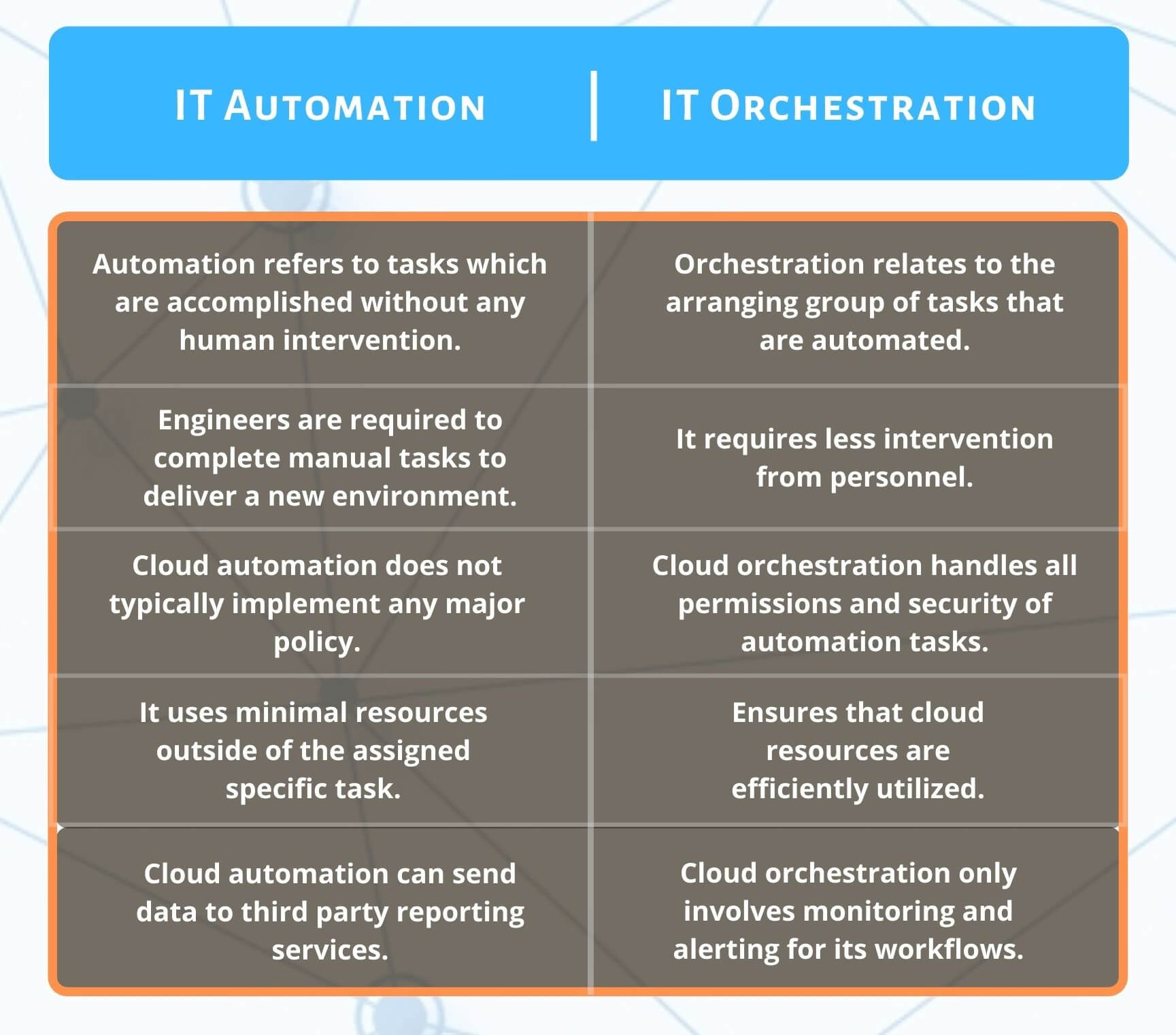Automation is a significant element for any company, no matter the size and the industry.
Whether you talk about IT or any other sector, it’s very likely to hear about Automation as a way of being cost-friendly. It exists to upgrade to better work and eliminate any errors.
The distinction between Automation and orchestration isn’t so confusing. Automation is a single process: one can automate a single task or workflow. While orchestration is plural, one can manage a collection of automated tasks.
These software applications and databases are on-premise or in the cloud. Both would make complex business processes run smoothly.
The more workload there is, the more one will be reliable on these automation tools. To understand Automation vs. orchestration better, we must consider various features.
Automation vs. Orchestration: Difference Across Parameters
Automation enables various businesses to gain and maintain the speed of operations. Also, with the help of different tools, it manages their functions and workloads on the cloud.
Automation is the primary element for all modern IT workflows. It reduces manual processes and increases robustness and reliability. Also, it anticipates a growing list of responsibilities.
Automation is defined as making one task run on its own. Automating a job can be applied to the desktop as well as the cloud. This single task can be anything:
- Launching the browser or internet services
- Stopping a service/network
- Integrating a software API
- Scheduling an email to a predetermined list
Technologists automate everyday tasks to improve their efficiency. Many companies of all sectors and sizes look for Automation to upgrade in scale.
Orchestration is most related to handling large-scale virtual environments or networks.
The planning & integration of automated tasks between distributed systems & services is some of the Orchestration features.
Whether on-premise or in the cloud— it modernizes and simplifies interconnected workloads, redundant tasks, and procedures.
By utilizing various orchestration tools, automating the arrangement becomes easy for complex systems.
All this of the above within the computing conditions and under direct automated processes. In order to support more comprehensive workflows.
So, while IT automation denotes automating one task, orchestration refers to the Automation of many tasks to increase efficiency.
- Automation tools and functionalities that are related, take place in a set order using particular groups or tools. Simultaneously, Cloud orchestration tools can count the various resources. Also, it can ensure that there is a degree of interoperability between resources.
- In Automation, it is essential to complete a set of manual tasks within a specific time frame to deliver a new environment. In comparison between both, orchestration requires less intervention from personnel.
- Automation uses minimal resources outside of the assigned specific task. Whereas Orchestration ensures that cloud resources are utilized efficiently.
- Cloud automation can send data to third-party reporting services. In contrast, orchestration considers monitoring and alerting systems for its processes.
Here is the list of similarities:
- The benefits of both are that it helps decrease the IT price and helps in choosing how to use the allocated budget towards innovation for the latest projects.
- Team contribution is precious, but hurdles in projects and tasks are very common. Automation and Orchestration help workflows & processes to cut the resistance within teams.
- Instead of user analysis on everyday redundant work, one can choose to manage projects. As it requires decision-making skills.
- Both help to Standardize workflows and products and improve the employee experience.
Conclusion
Automation quickly became renowned in the computer field as the tasks that IT had to execute became too much to handle manually.
After a few decades, a similar issue had arisen. There was a large number of processes and applications within the systems for technologists to manage.
A modest human error or faulty script and a critical process can quickly fail and lead to the overall business’s butterfly effect.
The orchestration tools do away with the strenuous automated processes. This happens by changing the program models’ underlying structure.
This makes it possible for coders, technologists, and executives to gather cross-platform methods, without depending upon code-scripts rapidly.
You May Also Like to Read:
Learn about the Best Practices of Cloud Orchestration
The Best Data Orchestration Tools that Businesses should be aware of



